Unlock the Secrets of Decrement Delay and Enhance Your Building’s Thermal Performance with Dynamic Envelope Design

Source: iStockphotos.
Do you know that we spend about 80–90% of our time at home or in other public indoor environments? Are you aware of the great impact of indoor environmental quality on your health and working performance? Thermal comfort is a key factor influenced by the design strategies and the material choices you implement in your projects.
The building envelope works as a dynamic interface between indoors and outdoors by regulating climate variability, thereby impacting the heating and cooling loads. The thermal comfort quality that the envelope provides depends, among other things, on the thermophysical performance of the construction materials combined as wall and roof systems. In other words, the building envelope can be described as the third skin for the human body that supports keeping the body temperature steady even though the outside temperature fluctuates.
Highlights
- The thermal performance of building envelopes is complex and dynamic, with a great impact on indoor comfort and energy efficiency.
- Climate conditions, building orientation, envelope design and its specific construction materials, occupants’ behaviour, and HVAC systems (Heating, Ventilation and Air Conditioning) influence the global energy consumption of buildings.
- Global warming potential, decrement delay and other thermophysical properties of building materials are crucial for low-carbon and energy-efficient building envelope design.
- Biobased insulation materials (straw, cork, wood fibre, paper wool, hemp) show better thermal and carbon performance in comparison to conventional ones (foam glass, PUR, XPS), according to the joint research by 2050 Materials and GHA Glenn Howells Architects.
Be aware of the dynamic thermal performance of building envelopes
The building envelope is a system that controls heat exchange between indoor and outdoor environments. The basic control mechanism is the acceptance or rejection of heat gain from the external and internal heat sources, establishing a new microclimate for the interior (Watson D. 1983).
The heat transfer process through the building envelope is complex and dynamic (Figure 1), which occurs through conduction, convection, and radiation. For example, in the daytime, solar radiation hits the external wall surface, a part of which is released to the outdoor environment, and the other part is absorbed and conducted across the material. The interior surface of the wall then exchanges heat with the room air and other surfaces through convection and radiation (Jihui Y. 2018).
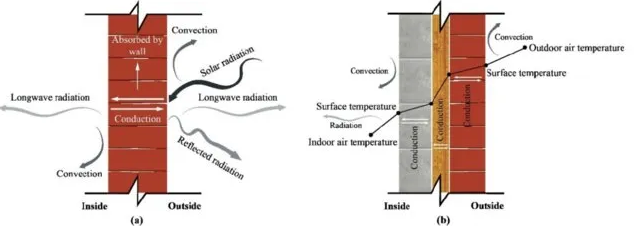
Figure 1. Heat transfer process across the (a) solid wall; (b) composite wall. Source: Nusrat et al, 2018.
The heat exchange rate and direction through the building envelope depend on several parameters, including solar gain, indoor and outdoor temperatures, material thermophysical properties, and exposed surface area. You can check out the brief glossary about thermophysical parameters at the end of this article if you feel lost with the terminology. Energy simulation software like TRNSYS, EnergyPlus and MATLAB help understand this complexity in detail for the global energy building performance.
What is decrement delay and why is it so important?
When considering the thermal and energy performance of external walls and roofs, we must keep in mind that the construction system’s performance is dynamic, hence the buildings’ overall performance as explained above. Due to national building standards, architects and designers are usually aware of construction materials’ thermal conductivity (λ-value) and thermal transmittance (U-value). However, there are other less known but relevant parameters, like the decrement delay, which could help us to make good decisions in the components of our building envelope, which will have a determinant impact on the indoor air temperature and heating or cooling demand of our projects.
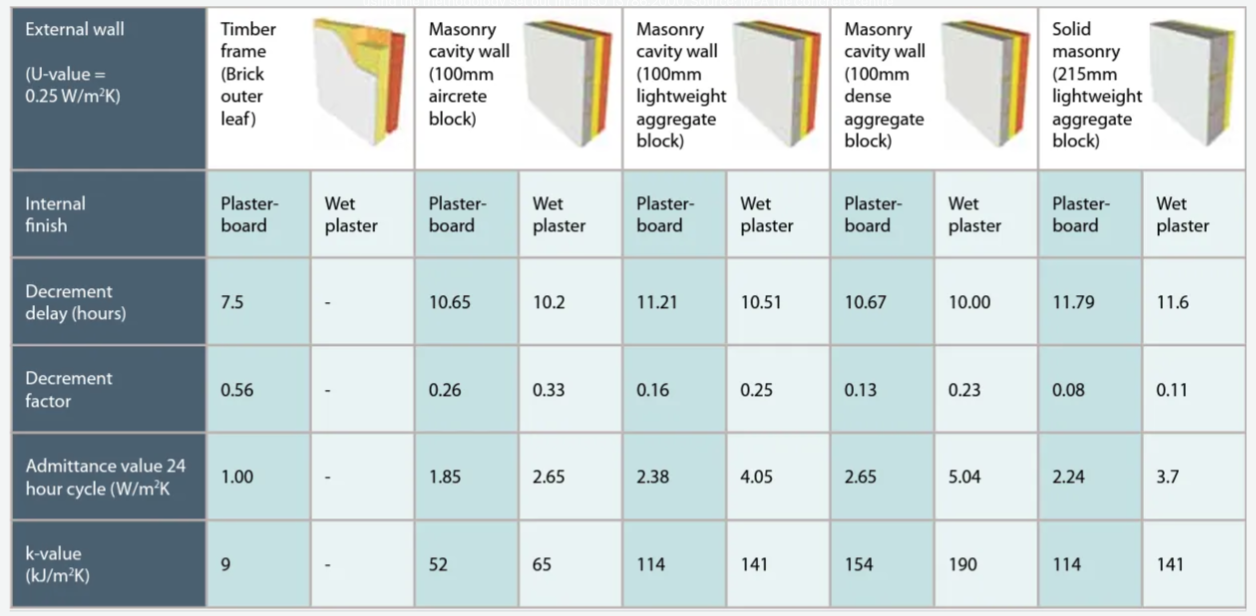
The decrement delay refers to the time it takes for heat generated by the sun to transfer from the outside to the inside of the building envelope. Hence, the decrement delay affects the building envelope’s dynamic performance and indoor thermal comfort. In practical terms, it is the time lag between the peak outer and inner surface temperature of a wall or roof, typically on a summer day, as external heat gains pass through in a wave-like motion.
The decrement delay is itself a property of thermal mass which describes how the density, heat capacity and thermal conductivity of a wall or roof slow the passage of heat from one side to the other (decrement delay) and also attenuate gains as they pass through (decrement factor).

According to how materials respond to the climate, the human settlement environment on earth can be categorised into the heat preservation priority and heat insulation priority climate zones. In the heat preservation priority climate, building materials are used to prevent external heat gain (hot zone) or internal heat loss (cold zone) since there is a wide disparity between indoor and outdoor temperatures (Jihui Y. 2018). Especially, in warm and hot climates or periods, decrement delay as well as purge ventilation play important roles in overheating mitigation.
 Tip: To reduce summer overheating a decrement delay of 6 to 12 hours is required, and purge ventilation should be used when the temperature outside has dropped (e.g. during the night hours).
Tip: To reduce summer overheating a decrement delay of 6 to 12 hours is required, and purge ventilation should be used when the temperature outside has dropped (e.g. during the night hours).
If you want to know more about decrement delay and thermal buffering, you can find other interesting resources on Greenspec and a free tool to calculate the dynamic thermal properties of construction elements on MPA the concrete center.
Consider both embodied carbon and decrement delay in your insulation choices
As discussed in our previous article, the best choices for insulation materials should consider both carbon and thermal performance as well as health risks. The “Illustrated Guide to Insulation Materials” is part of the research that 2050 Materials is carrying out to help designers make more climate-conscious decisions.
 “Decrement delay or time lag is, in particular, an essential element to consider in maintaining a cool temperature and limiting overheating due to diffusivity capacity” explains Sophia Ceneda (GHA Associate and Sustainability Lead).
“Decrement delay or time lag is, in particular, an essential element to consider in maintaining a cool temperature and limiting overheating due to diffusivity capacity” explains Sophia Ceneda (GHA Associate and Sustainability Lead).
According to our research, insulation materials offering a high decrement delay and a low carbon footprint are biobased such as straw (21 hr, 6.5 kg CO2e/m2 wall), cork (16 hr, 7.8 kg CO2e/m2 wall), wood fibre (11.4 hr, 5.6 kg CO2e/m2 wall), paper wool (11.1 hr, 8.6 kg CO2e/m2 wall) and hemp (9.5 hr, 8.1 kg CO2e/m2 wall). In the opposite scenario, there are mineral and fossil fuel-derived insulation materials whose use in buildings is paradoxically the most conventional, such as foam glass (8.8 hr, 69.6 kg CO2e/m2 wall), PUR (3.5 hr, 31.5 kg CO2e/m2 wall) and XPS (5.4 hr, 33.1 kg CO2e/m2 wall).
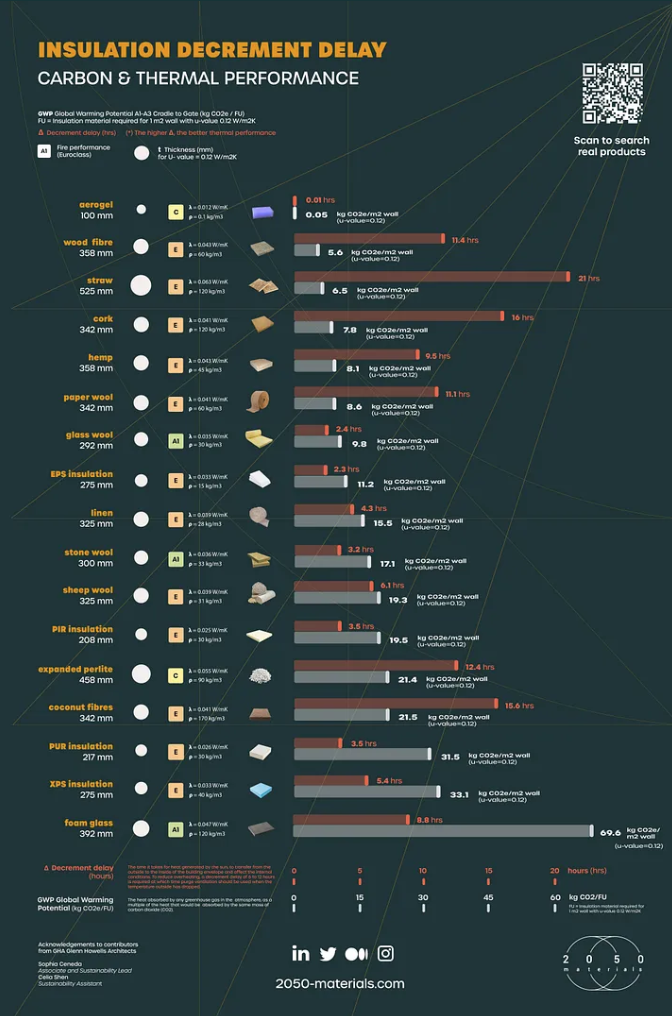
Analysing the GWP and other environmental indicators through the whole Life Cycle Assessment (LCA) of building materials helps us understand the consumption of resources, energy, and water involved in the manufacturing process, hence its environmental impact and contribution to Global Warming. Based on around 2200 EPDs (Environmental Products Declarations) compiled in 2050 Materials database and free-use platform, we have studied the carbon performance of 17 thermal insulation products of different resource origins.
For this work, we consider the life-cycle stages A1-A3 (i.e. cradle to gate or manufacturing emissions), and we exclude biogenic carbon. The end-of-life emissions for certain materials can have significant impacts. However, due to the high level of uncertainty about what may happen to a material at the end of its lifetime, as well as a scarcity of data for the end-of-life stages, we have decided to omit it in our research.
The functional unit (FU) for the GWP is the insulation material required for a 1m2 wall with a U-value of 0.12 W/m2K. Depending on each material’s apparent density and thermal properties, you would need different thicknesses of insulation materials for the same thermal transmittance (U-value). Hence, this is translated into different quantities that vary on the type of insulation material with a subsequent different environmental impact.
Never underestimate the potential of bio-based materials
One of the most relevant conclusions from this research is the potential of bio-based insulation materials in terms of carbon and thermal performance compared to conventional ones. Research run on sustainable construction by Guillaume Habert and Olga Beatrice Carcassi (ETH Zurich) justifies the need and technically feasible for shifts to biobased materials in construction in the transition period before 2050.
“Fast growing bio-based agricultural materials can store carbon in less than a decade and provide a realistic solution for building materials. Positive change can be created quickly by creating both supply push (agriculture) and demand pull (public procurement and regulatory demand)”, explains Guillaume Habert in this article.
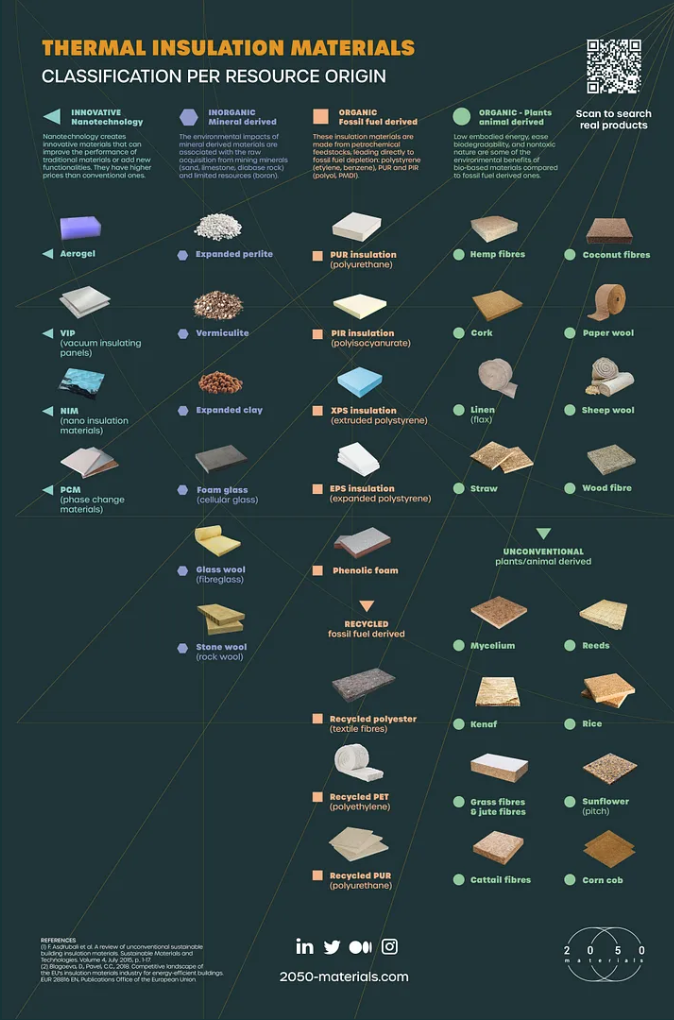
We encourage designers to research and implement other alternatives of insulation materials like biobased in their projects. You can follow the visual guide above to understand the variety of insulation materials classified per resource origin.
Get familiar with relevant thermophysical parameters
Decrement delay
Decrement Delay Refers to the time it takes for heat generated by the sun, to transfer from the outside to the inside of the building envelope and affect the internal conditions. Units: hours.
Decrement factor
Ratio between the cyclic temperature variation on the inside surface of a wall or roof compared to the outside surface. In practical terms, it basically describes the stability of the inside surface temperature, typically over the course of a summer day. Units: hours.
Density
The mass (or ‘weight’) per unit volume of a material and is measured in kg/m3. A high-density material maximises the overall weight and is an aspect of ‘low’ thermal diffusivity. Units: kg/m3.
Diurnal temperature variation
The daily temperature shift that occurs from daytime to night-time.
Diurnal heat flow
The heat that flows to and from a building or space over the course of 24 hours.
Heat transfer
The transition of thermal energy from a hotter object to a cooler object. Units: kJ/kg.
Specific heat capacity
The amount of heat required to raise the temperature of 1kg of a material by one degree Centigrade. It is an important factor in slowing up the transfer of heat. Units: J/kg⋅K.
Thermal conductivity (λ-value)
It measures the ease with which heat can travel through a material. For ‘low’ thermal diffusivity, ‘low’ conductivity is an essential part of the equation. Units: W/m⋅K.
Thermal diffusivity
Rate of transfer of heat of a material from the hot end to the cold end. It is calculated as the thermal conductivity divided by density and specific heat capacity at constant pressure. It measures the ability of a material to conduct thermal energy relative to its ability to store thermal energy. In effect, it is a measure of thermal inertia or ‘buffering’. Units: m2/hr.
Thermal mass
A concept in building design that describes how the mass of the building provides “inertia” against temperature fluctuations. Units: J/K
Thermal resistance (R-value)
The measure of a component’s ability to restrict the passage of heat across its thickness. The R-value is calculated by combining the thermal conductivity and the thickness of the material. Hence R=t/λ, where ‘t’ is the thickness. Used in connection with insulation, the higher the R-value, the more effective the insulation. Units: m2⋅W/K.
Thermal transmittance (U-value)
A measure of the overall rate of heat transfer, by all mechanisms under standard conditions, through a particular section of construction. This measure takes into account the thickness of each material involved and is calculated from R-values of each material as well as constants accounting for surface transmittance (Rsi and Rso, inner and outer surfaces respectively) and also for a small standard air gap (Rso). Units: W/m2⋅K.
Take action with 2050 Materials
If you are working on specifying thermal insulation materials, count on 2050 Materials support and educational contents. We will help you compile a suitable list of products and suppliers that best fit your project’s requirements. Our free-to-use 2050 Materials library offers a wide range of innovative, low-impact, and healthy materials in the market worldwide.

Do your own research on thermal insulation materials, here
If you are a manufacturer, join 2050 Materials to share your products on our platform to help designers make better choices in their climate-conscious projects. Reach out to manufacturers@2050-materials.com to book a demo, or simply visit our website to get started.
Acknowledgements & Credits
- Sophia Ceneda (GHA Associate and Sustainability Lead)and Celia Shen (GHA Sustainability Assistant) from GHA Glenn Howells Architects
- Chris Brookman from Back to Earth
Sources
Illustrated Guide to Insulation Materials by 2050 Materials.
Green specs https://www.greenspec.co.uk/building-design/decrement-delay/
Construction wiki https://www.designingbuildings.co.uk/wiki/Decrement_delay
The Green Self Builder https://thegreenselfbuilder.co.uk/green-building-glossary-d/
Habert, G. Fast-Growing Bio-Based Materials Can Heal the World https://www.buildingsandcities.org/insights/commentaries/cop26-biobased-materials.html
Saulles, T. Thermal mass explained.MPA The Concrete Centre: London, UK. ISBN 978–1–904818–71 https://kivifaktaa.fi/wp-content/uploads/2017/02/Thermal-Mass-Explained.pdf [accessed Jan 10 2023].
Jihui, Y. Impact of Insulation Type and Thickness on the Dynamic Thermal Characteristics of an External Wall Structure. Sustainability 2018, 10(8). Available from DOI https://www.mdpi.com/2071-1050/10/8/2835 [accessed Jan 10 2023].
Nusrat, J. et al. A Comparative Simulation Study of the Thermal Performances of the Building Envelope Wall Materials in the Tropics. Sustainability 2022, 12. Available from DOI https://www.mdpi.com/2071-1050/12/12/4892#B19-sustainability-12-04892 [accessed Jan 10 2023].
Udawattha, C.; Halwatura, R. Thermal performance and structural cooling analysis of brick, cement block, and mud concrete block. Adv. Build. Energy Res. 2018, 12. Available from DOI https://doi.org/10.1080/17512549.2016.1257438 [accessed Jan 10 2023].
Watson, D. Climatic Design: Energy-Efficient Building Principles and Practices; McGraw Hill Higher Education: New York, NY, USA, 1983; ISBN 978–0070684782.
Carcassi, O., et al. Material diets for climate-neutral construction. Environmental Science and Technology 56 (8) 2022. Available from DOI 10.1021/acs.est.1c05895 [accessed Jan 10 2023].
Related articles

The Most Interesting Low Carbon Products in Office Design
In this article and collection, we highlight 11 outstanding products that contribute to a lower carbon footprint in office design.
Read more
Top Low Carbon Building Boards: Performance, Benefits, and Use Cases
The building boards highlighted in this article and collection showcase low-carbon innovation in modern construction.
Read more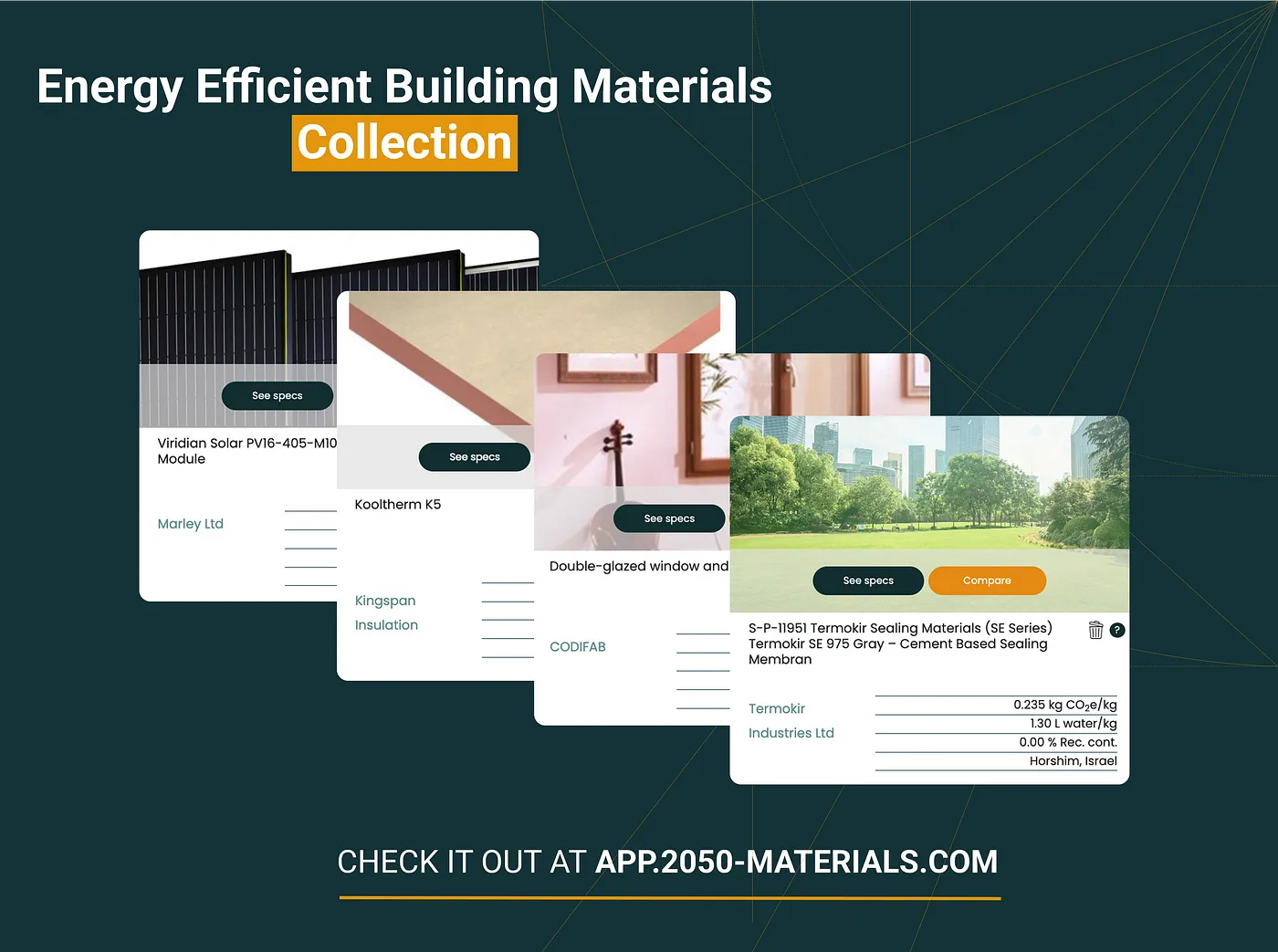
11 Interesting Energy Efficient Building Materials for Reduced Environmental Impact
Discover a collection of energy efficient building materials that not only reduce greenhouse gas emissions but also contribute to long-term durability.
Read more